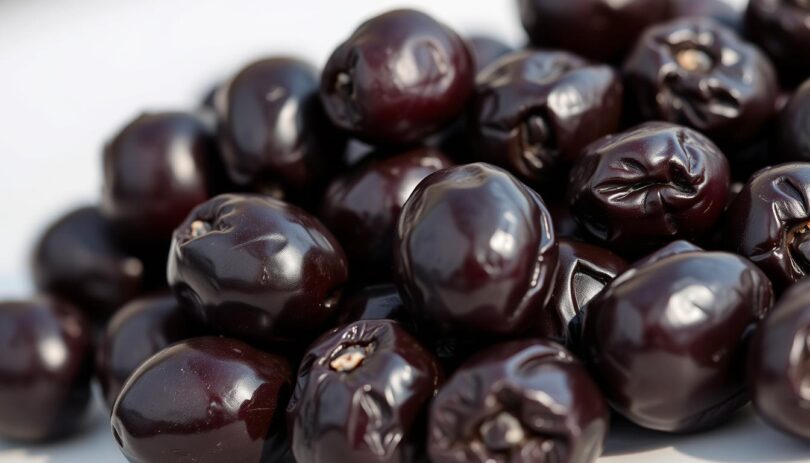Did you know that just three salted black olives can exceed a dog’s recommended daily sodium intake? While these briny treats might seem harmless, pet owners are increasingly curious about their safety—and for good reason.
Black olives aren’t toxic to pets, but they require careful preparation. High sodium levels, pits, and added seasonings pose hidden risks many owners overlook. This guide explores how to safely share this Mediterranean snack while prioritizing your furry friend’s health.
Veterinarians emphasize moderation when introducing new foods. Plain, pitted varieties offer antioxidants and healthy fats, but portion control matters. Always consult your vet before adding olives to meals—especially if your pet has existing health conditions.
This article breaks down nutritional benefits, potential hazards, and preparation tips. You’ll learn about different olive types, including how olive oil fits into canine diets. We’ll provide actionable advice backed by veterinary insights to help you make informed decisions.
From understanding choking hazards to recognizing signs of salt toxicity, we cover essential safety measures. Let’s explore how to balance variety and caution in your pet’s snack routine.
The Nutritional Scoop on Olives for Dogs
These Mediterranean gems pack vitamins A, E, and K alongside B-complex nutrients. When prepared safely, they offer pets small bursts of nutrition that complement regular meals. The key lies in understanding which components benefit your companion and how they work together.
Powerhouse Compounds in Every Bite
Olives contain polyphenols – natural fighters against cellular stress. These antioxidants help reduce inflammation, particularly beneficial for aging pets or those with joint discomfort. Monounsaturated fats support skin hydration and create that coveted shiny coat pet parents love.
Balancing Act for Better Digestion
The fiber content aids smooth digestion, though too much can upset sensitive stomachs. Compared to processed treats, olives provide natural nutrients without artificial additives. A single pitted olive offers about 0.1g of fiber – enough to help without overwhelming their system.
While olive oil shares similar benefits, opt for cold-pressed versions in tiny amounts. Always choose unsalted varieties and limit portions to avoid excess sodium. Remember: these fruits enhance meals but shouldn’t replace balanced pet food formulas.
Examining the Question: can dogs eat black olives?
Pet owners often wonder about sharing their favorite snacks with furry companions. While plain, pitted varieties occasionally make safe treats, several factors determine whether they’re appropriate for your pet’s diet.
Assessing Safety and Digestive Concerns
High sodium content remains the primary concern. Brined versions contain salt levels that strain canine systems, potentially leading to dehydration or kidney stress. Always rinse preserved varieties thoroughly before offering a taste.
Pits pose dual risks: choking hazards and intestinal blockages. Remove them completely, even if your pet typically chews food carefully. Stuffed or marinated options often include garlic or spices harmful to animals—stick to plain preparations.
Digestive reactions vary between pets. Some experience gas or loose stools after sampling new foods. Start with tiny portions and watch for signs like vomiting or diarrhea. These symptoms usually resolve quickly but warrant veterinary attention if persistent.
Moderation proves crucial—limit treats to one or two pieces weekly. Consult your veterinarian about dietary changes, especially for pets with heart conditions or sodium sensitivities. Remember: human snacks should never replace balanced meals designed for canine nutritional needs.
Types of Olives and Their Impact on Your Dog
Not all olives are created equal when it comes to canine safety. While these fruits aren’t inherently dangerous, preparation methods and added ingredients determine their suitability as occasional treats.
Nutritional Nuances: Black vs. Green
Black and green olives grow on the same tree but differ in ripeness. Riper black varieties typically have higher oil content, while green ones retain more chlorophyll. Both types offer antioxidants, but canned versions often carry excess sodium.
Plain pitted options work best for pets. Avoid those packed in heavy brine or seasoned with herbs. Fresh varieties rinsed thoroughly make safer choices than preserved counterparts.
Hidden Dangers in Enhanced Varieties
Stuffed or marinated olives frequently contain harmful ingredients. Garlic-stuffed versions pose toxicity risks, while blue cheese fillings introduce dairy concerns. Spicy marinades may irritate sensitive stomachs.
Always check labels for additives like onions or excessive salt. Oil-packed options require portion control – a single teaspoon of olive oil per 20 pounds of body weight suffices as an occasional supplement.
When sharing this Mediterranean snack, simplicity wins. Stick to basic preparations and prioritize your pet’s unique dietary needs over flavor variety.
Incorporating Olives into Your Dog’s Diet Safely
When adding variety to your pet’s meals, safety and moderation take priority. Follow these practical strategies to balance nutritional benefits with potential risks.
Portion Control and Pit Removal
Tailor servings to your companion’s size. Small breeds (under 20 lbs) should receive no more than half a pitted olive weekly. Medium pets (20-50 lbs) can handle one whole piece, while larger animals may safely enjoy two. Always remove pits completely – they’re choking hazards and may damage intestinal linings.
Introduce this snack gradually. Mix finely chopped pieces into regular meals once weekly. Watch for digestive changes like loose stools or reduced appetite. If reactions occur, discontinue use immediately.
Using Olive Oil as a Healthy Additive
Extra virgin varieties work best for pets. Add ¼ teaspoon per 10 pounds of body weight to kibble twice weekly. This supports skin hydration and creates a glossy coat without overwhelming their system.
Alternatives exist for sensitive stomachs. Consider plain pumpkin puree or steamed green beans as low-calorie substitutes. Always consult your veterinarian before making dietary changes, especially for pets with pancreatitis or weight management needs.
Track treat calories to maintain optimal health. All extras – including olive-based items – should never exceed 10% of daily intake. Use a kitchen scale for precise measurements when experimenting with new additions.
When to Seek Veterinary Guidance on Olive Consumption
Recognizing when your pet needs professional care ensures their safety with new foods. While most animals tolerate occasional olive treats well, certain situations demand expert evaluation.
Warning Signs: Vomiting, Diarrhea, and Lethargy
Watch for three key reactions after offering olives. Repeated vomiting within 12 hours signals digestive distress. Watery stools lasting over 24 hours indicate intestinal irritation. Unusual tiredness or refusal to play requires immediate attention.
Pets with heart conditions or kidney issues face higher risks from salty snacks. Those on prescription diets may experience medication interference. Always contact your veterinarian if symptoms persist beyond six hours.
Understanding the Impact of High Sodium and Fat
Excess salt strains vital organs over time. A single olive contains 35mg sodium – problematic for small breeds. Fatty acids in oil-packed varieties can trigger pancreatitis in susceptible animals.
Keep a food journal noting portion sizes and reactions. This helps veterinarians identify patterns quickly. For pets with sensitive stomachs, consider safer alternatives like fresh carrots or apples.
Early intervention prevents minor issues from becoming emergencies. Trust your instincts – if something seems off, schedule a checkup. Professional guidance keeps snack time both enjoyable and safe.
Wrapping Up Your Dog’s Olive Experience
Integrating new snacks into your pet’s routine requires thoughtful consideration. When prepared properly—pits removed and additives avoided—these Mediterranean treats offer nutritional perks without compromising safety. Moderation remains essential, especially with sodium-sensitive companions.
Veterinary guidance ensures dietary changes align with individual health needs. Olive oil shines as a supplement when used sparingly, promoting coat shine and skin hydration. Always start with tiny amounts and monitor reactions closely.
Successful treat integration balances variety with vigilance. Track your pup’s response to new foods, adjusting portions as needed. Remember: fresh, plain options work best for sensitive stomachs.
Share your olive-feeding stories or questions below! By combining expert advice with attentive care, you’ll keep snack time both enjoyable and nourishing for your four-legged friend.
FAQ
Are black olives toxic to pets?
Plain black olives aren’t toxic when served in moderation. Always remove pits and avoid varieties seasoned with garlic, onions, or excessive salt, which can harm pets.
How do black and green olives differ for pets?
Black olives are ripened longer, making them softer and slightly lower in sodium. Both types require thorough rinsing to remove brine or marinades before sharing.
What’s a safe portion size for small breeds?
Offer no more than 1–2 pitted olives weekly for toy breeds. Larger dogs can handle 2–3 occasionally, but always prioritize their regular diet.










Leave a Comment